How to Grow Leeks: Beginner's Guide to Sweet Harvests

Written by
Olivia Mitchell
Reviewed by
Prof. Martin Thorne, Ph.D.Discover the secrets to successfully grow leeks with 6 or more hours of direct sunlight per day
Attempt growing leeks in soil with a pH of between 6.0 and 7.0 that has been amended with 3-4 inches of compost
Water leeks weekly with approximately 1 inch of water to avoid tough stems
Blanch stems using a hill or paper collars for the best tender whites
Thin and harvest leeks at stem thickness of approximately 1 inch for the best flavor
Store leeks in sand-filled boxes for an extra 8 weeks of storage and freshness.
Article Navigation
Knowing how to cultivate leeks opens up a vegetable that laughs at frost and enhances winter soups. Unlike onions, they do not form bulbs, but instead develop stout stems over 120 or more days, which allows you to have fresh harvests long after the other crops have given up to the cold.
You may be surprised at how forgiving leeks are. They don't require perfect soil or constant care. I have grown them in areas of my garden that have been completely ignored, and they thrived where even the kale did not. Their secret? They only have a shallow root system, which allows them to live with minimal maintenance and stable moisture.
Begin with loose, compost-amended soil. Leeks can tolerate partial shade but they will reward those sunny spots with plumper stems. I learned early on that the timing does not matter as much as the technique. You can plant in spring or fall. Hill the soil up around the stems once a month for those iconic blanched shafts.
Many new gardeners tend to ignore leeks since they appear too fancy. Don't be. They are reliable plants. Just one sowing can feed you for months. Keep the weeds down and water them if they start drying out. Your wait will be rewarded with a sweet, onion-like flavor unavailable in stores.
Soil Prep & Planting Steps
Soil preparation is very important when it comes to growing leeks. For heavy clay soils, incorporate 30% compost and 20% coarse sand for drainage. Sandy soils require about 40% compost to retain moisture. My soil test is to squeeze a handful of soil and see if it crumbles, so it's not like a brick.
Plant your seeds no deeper than 1/4 of an inch (6mm) deep. When they are placed deeper than that, they have a hard time coming up to the surface. I usually keep a ruler handy, as I like my spacing to be precise. I keep the rows 12 inches (30cm) apart, as being crowded can lead to pests, disease, or weak stems. Overall, leeks like to be able to spread their roots whenever possible.
Make your choice: trenching, or hills. For trenching, dig a 6-inch deep (15cm) deep furrough in dirt for the trench method. Place seedlings in deep and as they grow backfill dirt to blanch white stems concerned about sunburn. To create a hill, mound soil around plants weekly. Hills may be easier and work better in windy areas.
Clarity, grit, and grit. Add 2 inches (5cm) of horticultural sand to the top 0 to 2 inches (~0 to 5cm) of topsoil before planting. Sandy soil is quick to rebel? No problem- layer compost as if it's lasagna, alternating 1 inch (2.5cm) of compost with some of the native soil removed from the hole until you reach the top of the hole. Water will ultimately settle things down into a productive bed.
Transplant shock comes to a complete stop. You should harden off your seedlings for 7 days before they can be planted. I take it slowly and gradually acclimate them to the sun, adding two hours per day of exposure. Cloudy days are your friends. Don't transplant when it is hot out, especially if you want to enjoy your planting without wilted dreams.
Soil Preparation
- Compost Ratio: 30% compost to 70% native soil for optimal nutrients
- pH Adjustment: Add lime if below 6.0; sulfur if above 7.0
- Drainage Test: Pour 1 gallon (3.8L) water, drains in <1 hour = ideal
Seed Starting
- Germination Time: 10-14 days at 70°F (21°C)
- Hardening Off: 7 days outdoors (start with 2 hours of shade)
- Transplant Signal: Seedlings pencil-thick (¼ inch/6mm diameter)
Mulching Guidelines
- Material: Use straw or shredded leaves
- Depth: 2 inches (5 cm) to retain moisture
- Timing: Apply after first watering
Fertilizer Application
- Initial Feed: 10-10-10 NPK at planting
- Mid-Season Boost: Side-dress with compost tea
- Frequency: Every 3 weeks
Row Spacing
- Narrow Rows: 12 inches (30 cm) for small gardens
- Wide Rows: 24 inches (60 cm) for easy access
- Pathways: 18 inches (45 cm) between beds
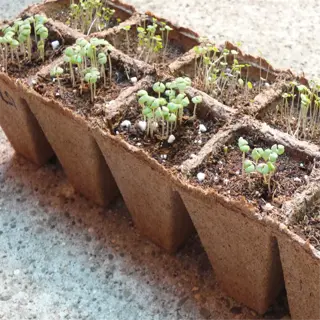
Seed Trays
- Material: Biodegradable peat trays reduce root shock
- Spacing: 1 seed per cell to avoid overcrowding
- Depth: ¼ inch (6mm) for consistent germination
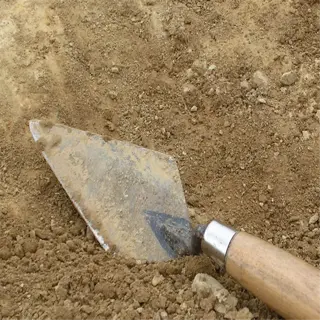
Trowel
- Blade Size: 3-inch width for trench digging
- Soil Loosening: Prevents root damage during transplanting
- Depth Marker: 6-inch notch for accurate holes

Soil pH Tester
- Accuracy: ±0.2 pH units for reliable readings
- Usage: Test 6 inches (15 cm) deep
- Calibration: Required before each season
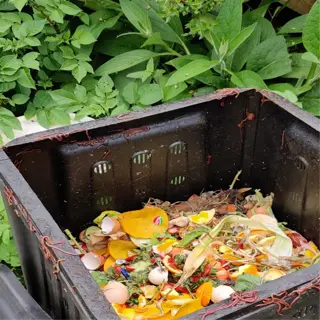
Compost Bin
- Capacity: 30 gallons (113L) minimum
- Aeration: Turn pile weekly with garden fork
- Location: Shaded area near water source
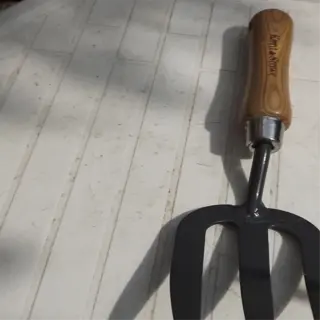
Garden Fork
- Tine Length: 10 inches (25 cm) for deep turning
- Material: Stainless steel resists rust
- Weight: 3 lbs (1.4kg) for easy handling
Best Time to Plant Leeks
In USDA Zones 3-5, you should plant leeks after frost has dissipated. Ideally, it is beneficial to seed when temperatures exceed 45°F (7°C) in the soil. In my Minnesota garden, I plant mid-April, after the maple leaves have expanded. Texans should wait as long as February, runny seedlings slow down in cool soil. Trust your frost calendars before you think you can guess.
Spring sowing leads to harvesting in July but risks heat stress over the summer. Leeks sown in the fall in Zones 7-10 (where they may also have suffered some freezing) generate sweeter stems during the winter chill. Even in Oregon, I've been able to grow giant leeks from seeding in August. Cool autumn weather will plump the stems better than any trick they have loaded up in greenhouses!
Use a meat thermometer to check soil temperature. 50°F (10°C) is a good temperature for seeds to wake up gently, while below 40°F (4°C), germination is stalled. I typically pre-warm clay soils with black landscape fabric for about two weeks. As for sandy soils, they wake up more quickly but require more water.
For northern gardeners, they have a short period. Start transplants in a flat 10 weeks before their last frost. Southern growers can take advantage of their milder winters and harvest a staggered crop. For example, my neighbor in Arizona is harvesting leeks in March from seeds sown in October. Grow for your climate, not what the seed packet says.
During the apple bloom phase in more humid climates, one should avoid planting due to increased fungal pressures. If you live near the coast, you can plant anytime except for the monsoon months. I lost one of my Seattle crops in a July rain event. Now, I plan my planting around dry periods, not calendars.
Northern Climates
- Spring Planting: After last frost (May 1-15)
- Fall Planting: Start seeds indoors June-July
- Soil Temp: 45°F (7°C) minimum for transplants
Southern Climates
- Spring Planting: February-March
- Fall Planting: September-October
- Heat Protection: Shade cloth above 85°F (29°C)
Coastal Regions
- Year-Round: Avoid rainy seasons
- Salt Protection: Mulch with seaweed
- Spacing: 8 inches (20 cm) for airflow
Mountain Zones
- Short Season: Start indoors 12 weeks pre-frost
- Frost Cloth: Use until June 15
- Harvest: Before first September frost
Indoor Start
- Timing: 8-10 weeks before outdoor planting
- Light: 14 hours/day under grow lights
- Hardening: 7-day gradual outdoor exposure

Soil Thermometer
- Range: 20°F to 120°F (-6°C to 49°C)
- Depth: Insert 4 inches (10 cm) for accuracy
- Best Use: Morning readings for consistency
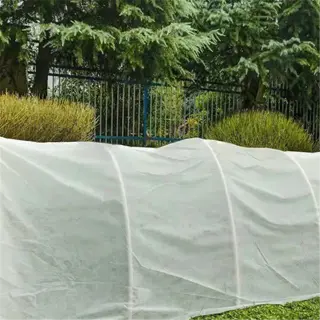
Frost Cloth
- Material: BPA-free polypropylene
- Coverage: 6x8 ft (1.8x2.4 m) per sheet
- Installation: Hoops to prevent leaf contact
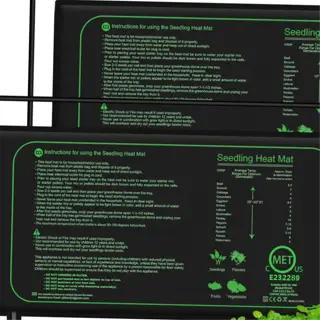
Seedling Heat Mat
- Temperature Control: 68°F-86°F (20°C-30°C)
- Size: 10x20 inches (25x50 cm) fits standard trays
- Safety: Auto-shutoff after 12 hours

Rain Gauge
- Capacity: Measures up to 5 inches (12.7 cm)
- Placement: 2 ft (60 cm) above ground
- Calibration: Check weekly for debris
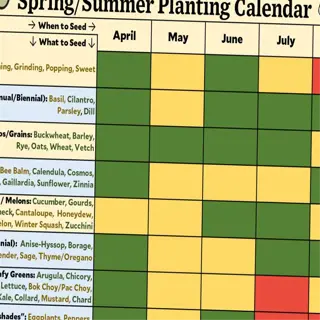
Gardening Calendar
- Frost Dates: Track last spring/first fall frost
- Moon Phases: Optional planting guide
- Custom Alerts: Set reminders for transplanting
Water, Feed & Blanch for Success
Leeks prefer deep watering over light sprinklers. Weekly soak the soil to 8 inches (20cm) to grow roots. Shallow watering results in lazy roots. I use a drip line for 30 minutes twice a week. Overhead sprays? They invite slugs and spread rust faster than gossip.
For feeding seedlings, use 10-5-5 for upper leaf growth. Once the plant stems are the size of a pencil, switch to 5-10-10 for deeper rooting. My cousin in Texas uses fish emulsion every 14 days. If you apply too much nitrogen, you'll get floppy greens instead of firm white shafts. Finding that balance is important.
Collars versus hilling divides gardeners into two camps. Hill soil once or twice a week to create more gradual blanching. Collars? Simply slide a roll of toilet paper tube over your young plants (I have found hilling to be more productive in rainier climates, as collars rot out fast in cool, damp springs, or do well in dry Utah summers).
Wet soil indicates trouble. Overwatering is deadly for your plant roots and invites onion maggots.I always made sure the top inch (2.5cm) of soil was dry before watering. My worst crop of garlic followed a rainy June, followed by weak, limp stems and yellowing leaves. Now, I check the soil with a chopstick before grabbing my gardening hand hose.
Watering Depth
- Target Zone: 6-8 inches (15-20 cm) root depth
- Test Method: Probe soil with wooden stick
- Avoid: Wetting foliage to prevent rust
Fertilizer Types
- Seedling Stage: 5-10-5 for root development
- Mid-Season: 15-5-10 for stem growth
- Pre-Harvest: 0-10-10 to reduce nitrogen
Blanching Methods
- Hilling: Mound soil gradually over 6 weeks
- Collars: Use recycled cardboard tubes
- Timing: Begin when stems reach ½ inch (1.3 cm)
Pest Prevention
- Deterrent: Garlic spray for onion maggots
- Trap Crops: Radishes near leek rows
- Inspection: Check leaf bases weekly
Moisture Retention
- Mulch: 3-inch (7.6 cm) straw layer
- Drip Lines: 12-inch (30 cm) spacing
- Monitoring: Use moisture meter probes
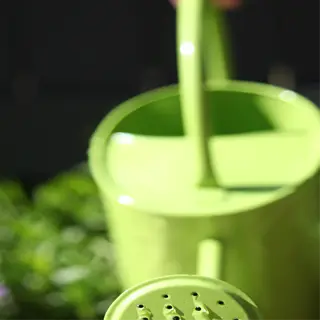
Watering Can
- Capacity: 2 gallons (7.5L) for deep watering
- Nozzle: Adjustable rose head
- Material: Galvanized steel rust resistance
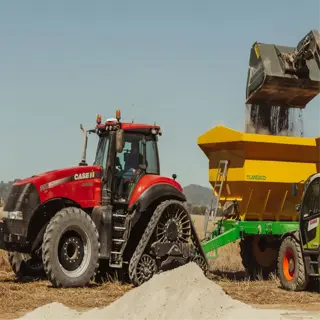
Fertilizer Spreader
- Settings: 5 granularity levels
- Coverage: 100 sq ft (9.3 m²) per load
- Cleanup: Rinse after organic use
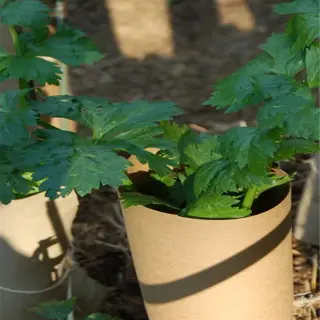
Blanching Collars
- Diameter: 3 inches (7.6 cm)
- Height: 8 inches (20 cm) minimum
- Material: Biodegradable cardboard
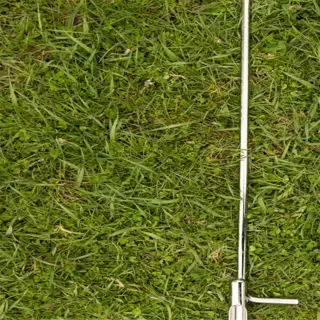
Soil Probe
- Depth: 12-inch (30 cm) stainless rod
- Readings: Instant dry/moist/wet
- Calibration: Weekly pH checks
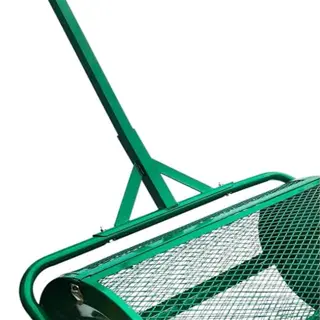
Mulch Spreader
- Capacity: 5 cubic ft (142L)
- Adjustment: 1-3 inch (2.5-7.6 cm) depth
- Handling: Ergonomic wooden handles
Harvest and Store Like a Pro
You can harvest leeks as the stems reach 1 inch (2.5 cm) thick. Use a garden fork or spade to loosen the soil up to 12 inches (30 cm) from the base of the leek to make removal of the leek easier. The first frost tastes the sweetest. I wait to harvest the final leeks until the first hard frost has occurred in my Zone 5 garden.
Refrigeration keeps leeks very firm for 2 weeks. Wrapping the unwashed stems in damp paper towels works best. For 8-week storage, bury the roots in boxes of damp sand in a cellar at 32-40°F (0-4°C). I have roots in my root cellar until March, if I check the cardboard box for mold weekly.
Blanching helps keep texture intact. Slice leeks and boil for 90 seconds, then plunge into an ice bath. Pat the leeks dry and freeze. I vacuum-pack portion sizes for soup. The air creates a freezer burn, which isn't delicious. Use thawed leeks in cooking, but they are not crunchy and won't work well in salads.
Trim roots back 1 inch (2.5 cm). Leave a 1-inch (2.5 cm) section of green above the white shaft. Ragged cuts promote rot. I sterilize the shears with rubbing alcohol between every plant. A clean cut should heal more quickly than a torn one.
Harvest Signals
- Visual Cue: Stems ≥1 inch (2.5 cm) thick
- Leaf Color: Dark green with upright posture
- Frost Warning: Harvest within 48 hours of first frost
Cleaning Steps
- Rinsing: Use pressurized hose nozzle
- Drying: Air-dry 2 hours in shade
- Grit Removal: Slice lengthwise to flush soil
Refrigeration
- Temperature: 32°F-40°F (0°C-4°C)
- Humidity: 90-95% in crisper drawer
- Duration: 2-3 weeks max
Root Cellaring
- Container: Wooden box with damp sand
- Layering: Stems vertical, roots down
- Inspection: Remove moldy stems weekly
Freezing Prep
- Blanching: 1 minute in boiling water
- Cooling: Ice bath for 2 minutes
- Portioning: 1 cup (240 mL) per freezer bag
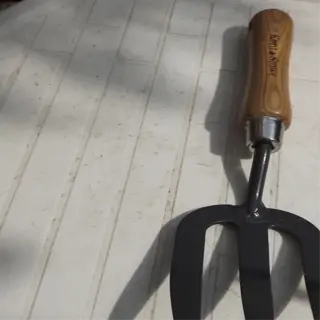
Garden Fork
- Tine Length: 10 inches (25 cm)
- Leverage: Reduces stem snapping
- Grip: Cushioned non-slip handle

Storage Boxes
- Material: Untreated pine for airflow
- Dimensions: 18x12x8 inches (45x30x20 cm)
- Capacity: 20 leeks per box

Freezer Bags
- Thickness: 4 mil puncture resistance
- Seal: Double zipper lock
- Labeling: Write harvest date with marker

Root Cellar
- Temperature: 32°F-40°F (0°C-4°C)
- Shelving: Slatted wood for ventilation
- Monitoring: Hygrometer for humidity checks
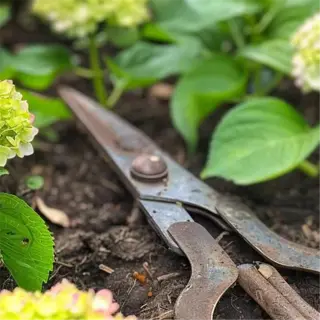
Pruning Shears
- Blade Type: Curved for clean cuts
- Cut Capacity: ¾ inch (1.9 cm) stems
- Maintenance: Wipe with food-safe oil
Top 3 Varieties for Home Gardens
American Flag leeks flourish in places that experience cold winters because they can survive extremely cold temperatures of down to -10°F (-23°C) when mulched properly, they are the backbone of my Minnesota garden. They are strongly flavored like an onion, but not too strong to be added to a stew. For the mild onion flavor included in the stew, the 130 days for maturity tests your patience, they can be frozen for the winter and hold texture when cooked afterward.
To have a quick win. King Richard prepares salad-ready stems in 75 days. I grow these in 12-inch (30cm) pots on my patio. The slender form will work well in small spaces. Summer salads love this flavor in the raw. Fertilize weekly to reach pencil-thick stems by July.
Giant Musselburgh is heirloom hardy to Zone 7+. It takes 150 days from now until maturity, yielding end-of-season 2-inch (5cm) thick succulent stems, great for roasting. They have a blue-green leaf that can withstand coastal rains better than most. Bang it 60 days with 3-5 seeds per cell, cover with frost fabric cover until they come up and you'll have saved seeds for next year.
Container gardeners must consider King Richard above all else. It is a variety that can develop shallow roots and adapt to 5-gallon buckets with drainage holes. I mix some perlite into potting soil for drainage. At around 60 days you can harvest baby leeks, or you can wait until they reach their full size. King Richard is flexible, which is nice compared to some more fussy varieties.
American Flag
- Cold Tolerance: Survives -10°F (-23°C) under mulch
- Flavor: Mild onion-like, ideal for soups
- Spacing: 8 inches (20 cm) in rows
King Richard
- Container Growth: 12-inch (30 cm) pots
- Harvest Window: 3 weeks longer than most
- Pest Resistance: Deters onion maggots
Giant Musselburgh
- Winter Care: No digging required in mild climates
- Stem Length: 10+ inches (25 cm) blanched
- Seed Saving: Biennial, harvest Year 2
Lancelot
- Disease Resilience: Immune to leek rust
- Soil Preference: Thrives in sandy loam
- Yield: 2 lbs (0.9 kg) per plant
Tadorna
- Aesthetic Value: Decorative purple stems
- Culinary Use: Holds shape when roasted
- Companion Plants: Carrots, celery
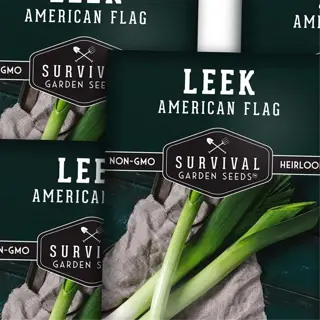
American Flag Seeds
- Germination: 85% success at 70°F (21°C)
- Packet Size: 500 seeds for 50-foot rows
- Sow Depth: ¼ inch (6 mm)

King Richard Seedlings
- Transplant Age: 10-week-old plants
- Root Ball: 3-inch (7.6 cm) peat pots
- Hardiness: Tolerates light frosts

Giant Musselburgh Mature
- Stem Diameter: 2 inches (5 cm) average
- Winter Color: Blue-green foliage
- Harvest Tool: Serrated garden knife

Tadorna Purple Stems
- Color Intensity: Deepens below 50°F (10°C)
- Culinary Tip: Grill whole stems
- Storage: 2 months in root cellar
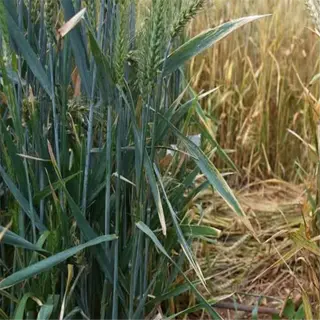
Rust-Resistant Varieties
- Prevention: Airflow + drip irrigation
- Treatment: Copper fungicide spray
- Recovery: Remove infected leaves
5 Common Myths
Leeks need complete shade to prevent summer bolting.
Leeks need 6+ hours of daily sun for proper growth. Excessive heat will stress the plants. Shade cloth (30%) during extreme heat waves is sufficient. Inconsistent watering is the culprit for bolting and not sunlight.
The green tops of leeks are too fibrous to consume.
The green leaves of leeks are edible and filled with flavor. Chop them finely to use in soups/stocks orthing of flavor. It is not the green leaves that are tough, it is the lengthy exposure without being blanched.
Leeks grown in containers will naturally produce a lower yield.
When growing leeks in containers, you can achieve garden yields with pots that are 12 inches deep and weekly fertilizer. Choose bushy varieties, such as 'King Richard' and make sure to give them consistent moisture and you will get stems that are 1 inch thick.
Leeks do not tolerate temperatures below 20°F (-6C).
Mature 'American Flag' leeks can tolerate 0°F (-18C) growing in a mulch of 12 inches of straw! The cold hardiness of leeks results from natural antifreeze compounds in the leaf cells.
Blanching leeks takes money or gardening tools.
Blanching can use free recycled materials: roll newspaper into tube, mound soil around stems, or rings cut from milk jugs. All supplies work fine for at-home gardeners.
Conclusion
Leeks present their versatility by doing equally well in snow-covered gardens as they do in summer containers. I pull them fresh from icing December in Michigan and July humidity in Georgia. Unlike their tender crop relatives, they are adjustable. Plant them every 3 weeks and you won't run out of the stems for your soups and quiches.
Space out the planting timetable throughout the yearly cycles. Begin ‘King Richard' in March for July salads. In June, plant the ‘American Flag' for winter stews. My Oregon plot produces 9 months of leeks with this technique. If the designated planting window passes, varietals in containers will accommodate you better than varietals grown in the ground.
During cold weather, leeks can be turned to sugar, while also bringing your grocery bill down. Grocery stores sell leeks for $2 each in the winter. My 10-foot row produces 30 leeks for $3 in seed. Frost will convert their starches to sugars, a free upgrade of nature. You can look forward to roasted stems straight from the land of snow.
As the best money-saving crop, leeks will outlast even lettuce, in spring and kale, in fall. I always go ahead and tuck seedlings in between tomato plants and tulips; there's no need to devote a bed to leeks. Skip the supermarket's bunch of leeks, and you've saved $200/year. Each time you harvest leeks, you improve your soil. Leeks leave the garden better than they found it!
External Sources
Frequently Asked Questions
How long does it take to grow leeks?
Leeks typically require 75-150 days to mature, depending on the variety. Early-season types like 'King Richard' reach harvest size in 75 days, while overwintering varieties like 'American Flag' need 120+ days for full development in colder climates.
What should not be planted near leeks?
Avoid planting beans and peas near leeks. These legumes release compounds that can inhibit leek growth through allelopathy. Instead, choose compatible companions like carrots or celery that don't compete for nutrients.
Can leeks survive winter in the garden?
Leeks are biennials but grown as annuals. In Zones 7-11, they can overwinter under thick mulch. Frost actually sweetens their flavor, but prolonged freezing below 10°F (-12°C) without protection will damage plants.
What sunlight conditions do leeks require?
Leeks thrive with 6+ hours of direct sun daily. While they tolerate partial shade, insufficient light results in thin stems. Morning sun with afternoon shade works well in hot southern climates to prevent scorching.
How do you prepare soil for leeks?
Ideal leek soil needs:
- Well-drained loam with pH 6.0-7.0
- 3-4 inches of compost mixed 12" deep
- Avoid fresh manure to prevent fork-shaped roots
- Balanced 10-10-10 fertilizer at planting
Can you grow leeks in containers?
Yes, use 12"-deep pots with drainage holes. Choose compact varieties like 'King Richard' and maintain consistent moisture. Container leeks need weekly liquid fertilizer since nutrients wash out faster than in ground beds.
Why are my leeks forming bulbs?
Bulbing occurs when leeks experience stress from temperature fluctuations or inconsistent watering. While edible, bulbous bases indicate suboptimal growing conditions. Maintain even moisture and avoid planting too early in cold soil to prevent this.
What part of leeks is edible?
Both the white stem and green leaves are edible. The white portion is tenderest, while green tops add flavor to stocks. Remove tough outer layers before cooking older, larger leeks.
How often should leeks be watered?
Water deeply 1-2 times weekly for 1" total. Sandy soils need more frequent watering. Use drip irrigation to prevent soil compaction. Reduce watering 2 weeks before harvest to concentrate flavors.
Why do leek stems stay thin?
Thin stems result from:
- Insufficient nitrogen - feed every 3 weeks
- Overcrowding - maintain 6" spacing
- Shallow planting - hill soil gradually
- Inadequate sunlight - relocate to sunnier spot

